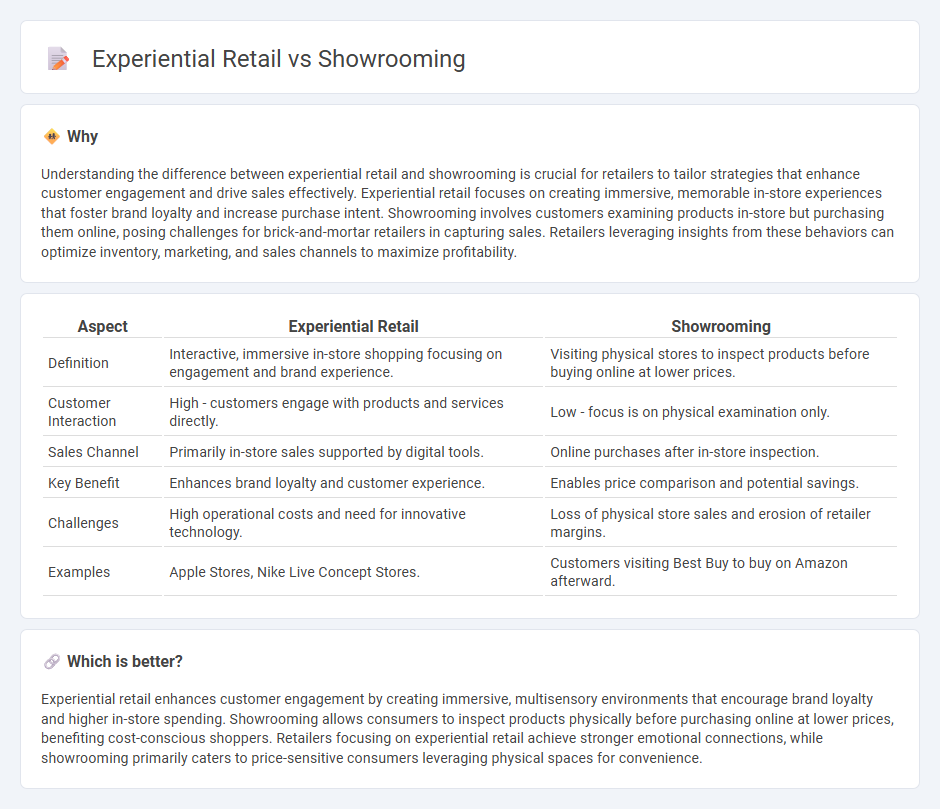
Experiential retail transforms traditional shopping by creating immersive, sensory-rich environments that engage customers beyond mere transactions, fostering brand loyalty and emotional connections. Showrooming challenges physical stores as consumers visit showrooms to examine products before purchasing them online at lower prices, highlighting the need for retailers to integrate digital and physical experiences. Discover more about how experiential retail strategies can counter showrooming trends and revolutionize customer engagement.
Why it is important
Understanding the difference between experiential retail and showrooming is crucial for retailers to tailor strategies that enhance customer engagement and drive sales effectively. Experiential retail focuses on creating immersive, memorable in-store experiences that foster brand loyalty and increase purchase intent. Showrooming involves customers examining products in-store but purchasing them online, posing challenges for brick-and-mortar retailers in capturing sales. Retailers leveraging insights from these behaviors can optimize inventory, marketing, and sales channels to maximize profitability.
Comparison Table
| Aspect | Experiential Retail | Showrooming |
|---|---|---|
| Definition | Interactive, immersive in-store shopping focusing on engagement and brand experience. | Visiting physical stores to inspect products before buying online at lower prices. |
| Customer Interaction | High - customers engage with products and services directly. | Low - focus is on physical examination only. |
| Sales Channel | Primarily in-store sales supported by digital tools. | Online purchases after in-store inspection. |
| Key Benefit | Enhances brand loyalty and customer experience. | Enables price comparison and potential savings. |
| Challenges | High operational costs and need for innovative technology. | Loss of physical store sales and erosion of retailer margins. |
| Examples | Apple Stores, Nike Live Concept Stores. | Customers visiting Best Buy to buy on Amazon afterward. |
Which is better?
Experiential retail enhances customer engagement by creating immersive, multisensory environments that encourage brand loyalty and higher in-store spending. Showrooming allows consumers to inspect products physically before purchasing online at lower prices, benefiting cost-conscious shoppers. Retailers focusing on experiential retail achieve stronger emotional connections, while showrooming primarily caters to price-sensitive consumers leveraging physical spaces for convenience.
Connection
Experiential retail enhances customer engagement by creating immersive in-store experiences that encourage product interaction, which contrasts with showrooming where consumers visit physical stores to examine products but make purchases online. Retailers leverage experiential retail to counteract showrooming by offering unique sensory experiences, personalized services, and immediate product availability that online platforms cannot replicate. Integrating technology such as augmented reality and interactive displays in stores further bridges the gap between physical and digital shopping, enhancing customer satisfaction and reducing showrooming behavior.
Key Terms
Omnichannel
Showrooming involves customers examining products in physical stores while planning to purchase online, leveraging digital channels for better prices or convenience, which challenges retailers to integrate seamless online-offline experiences. Experiential retail emphasizes creating immersive, engaging in-store environments that blend digital and physical touchpoints, fostering brand loyalty through interactive technology and personalized services. Explore how omnichannel strategies balance showrooming and experiential retail to enhance customer engagement and drive sales across multiple platforms.
In-store engagement
Showrooming involves customers visiting physical stores to explore products before purchasing online, often seeking convenience and better prices, which challenges traditional retail models. Experiential retail emphasizes immersive in-store engagement through interactive displays, personalized services, and sensory experiences to drive customer loyalty and increase sales. Discover more about how brands leverage these strategies to enhance retail performance and customer satisfaction.
Mobile integration
Showrooming leverages mobile integration by enabling customers to browse products physically while using smartphones to compare prices and read reviews online, enhancing informed purchasing decisions. Experiential retail incorporates mobile technology to create immersive, interactive store environments, utilizing apps, AR, and personalized notifications to engage shoppers deeply. Explore how mobile integration is transforming retail strategies to elevate consumer experiences and drive sales.
Source and External Links
Showrooming & Webrooming: What It Is, Benefits, How To (2024) - Showrooming is a shopping behavior where consumers visit stores to examine products in person but purchase them online, often due to better prices or convenience, and retailers are now adapting by using stores as showrooms with strategies like ship-to-customer fulfillment.
Showrooming - Wikipedia - Showrooming involves checking products in brick-and-mortar stores and then buying them online, potentially at a lower price, and although initially seen as a threat to traditional retailers, data also shows customers using devices in-store often still make purchases.
Showrooming - Salsify - Showrooming allows shoppers to physically evaluate products in-store before buying online, which benefits especially for items needing a fit or tactile assessment, and some retailers embrace it by offering easy online purchase options such as discounts or free shipping to capture the sale.
 dowidth.com
dowidth.com